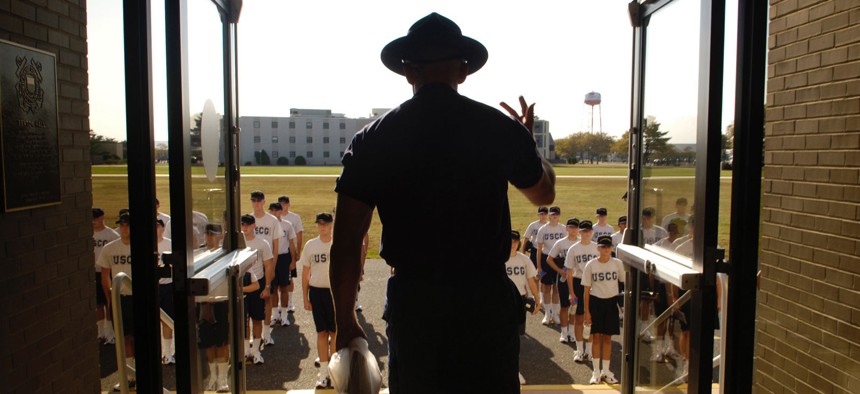
A U.S. Coast Guard company commander instructs new recruits to stand up straight outside of Sexton Hall at Coast Guard Training Center Cape May, NJ, Sept. 22, 2005. USCG photo by PAC Tom Sperduto
Military Retirement Changes Could Cut Into New, Old Troops' Benefits
Under the current system, personnel who serve 20-plus years get a pension. But what about everyone else?
This one seems like a no-brainer. If this year's Senate Defense authorization bill gets enacted, soldiers like the now-famous "American sniper" Chris Kyle would be able to leave the military with something in their back pockets for retirement. Kyle had 10 years of service in the Navy and served four tours in Iraq. But when he was honorably discharged in 2009, he had no employer-sponsored retirement savings.
In the eyes of a powerful reform commission, that's a little ridiculous. Heck, even Wal-Mart and 7-Eleven offer 401(k) plans with company matches for employee contributions.
Kyle is a high-profile example of one of the biggest defects in military compensation: 83 percent of men and women in uniform exit the armed forces without any retirement funds. Only those who stick around for 20 years are given the sweetest retirement deal—pensions for life. It's not fair to the rest of the soldiers. It hurts recruitment. It doesn't reflect the modern workforce.
Those are the findings of the Military Compensation and Retirement Modernization Commission, a Congress-ordered group, which recommended earlier this year that the military switch from an inflexible defined-benefit plan to a blended retirement plan that includes 401(k) investment options for all service members. Both the House and Senate versions of the Defense authorization bill include language largely reflecting the commission's recommendations. They would make retirement savings available to 75 percent of service members, excluding only those who serve less than two years.
The Senate version, which is being touted by Armed Services Committee Chairman John McCain as one of the biggest leaps forward in military compensation, would vest service members in a thrift savings plan after two years on the job. At that point, the military would match their own monthly contributions up to 5 percent of their salaries. All service members would start with a 1 percent monthly contribution from the government.
(See also: Pentagon Backs Major Changes to Retirement System)
In an interview, McCain told National Journal that he has been waiting almost 30 years to modernize the compensation of military personnel. He considers this year's proposed changes in retirement benefits to be one of the most significant parts of the Defense bill.
He took those statements to the Senate floor earlier this month. "The retirement reforms in this legislation will enable service members to save for retirement earlier in their careers, create a new incentive to recruit millennials, and increase retention across the services," he said.
Significant, yes. Controversial, no. There has been little public debate in Congress about the proposed changes to the Defense authorization and no amendments regarding retirement benefits. In part, that's because members of both the House and Senate Armed Services Committees agreed two years ago to wait until the military-compensation commission came out with its recommendations before acting. When the commission's report was published in January, the committee chairmen essentially adopted the recommendations in their entirety. There were few surprises in the report, but it gave lawmakers the ironclad justification they felt they needed to put the thrift savings plan into the Defense bill.
Why did they need a commission to back them up? There is a catch to the new system. It would actually reduce a 20-year service member's pension by about 20 percent, which has caused angst for some military brass. But if those same soldiers were to contribute to the thrift savings plan, their total retirement packages would be almost 20 percent higher, according to the commission.
Many soldiers' groups heartily endorse the changes. They have been given the seal of approval by the Veterans of Foreign Wars, the Reserve Officers Association, the National Guard Association, the Enlisted Association of the National Guard, and the Air Force Association.
Committee staffers have worked doggedly to please everyone with a carefully crafted deal that preserves the old pension promises for service members. For example, current service members can opt in to the new 401(k) system, but it isn't required. Those who have worked most closely on the project are pleased with its outcome, arguing that the changes are long overdue. Now it's just a matter of getting past other political hurdles to get them enacted.
NEXT STORY: Report: US Needs New Small Nuclear Bombs